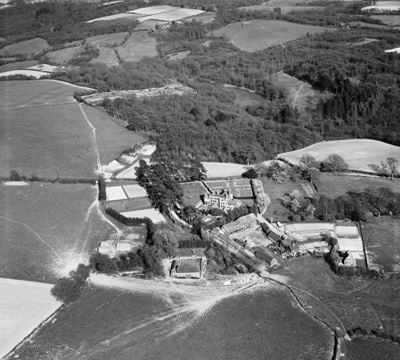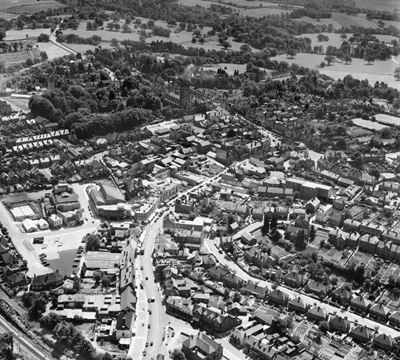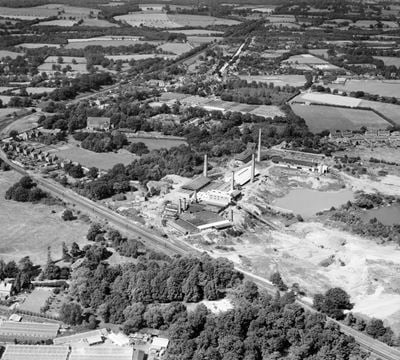Mid Sussex
Explore hidden histories, historic photos, and things you never knew about Mid Sussex from the collections and archives of Historic England.
Discover your local listed buildings and places
Introducing some of Mid Sussex's most historic sites, included in the National Heritage List for England. Some of these captions have been summarised by AI. Click through for the official List entry. Skip this section and go to place by numbers
Stonehurst
Ardingly
Stonehurst, designed by Thomas H Mawson and architect Norman Searle in 1907, is a notable historic estate with extensive pleasure grounds and gardens in the Sussex weald.
Wakehurst Place
Ardingly
Wakehurst Place, a garden developed starting in the early 20th century by Gerald Loder, features diverse plant collections managed by the Royal Botanic Gardens, Kew.
Wakehurst Place
Ardingly
Wakehurst Place, built by Sir Edward Culpeper in 1590, is now managed by Kew Gardens. Notable historical tenants include Viscount Canterbury and Sir Alexander Cockburn.
Borde Hill
Ansty and Staplefield
Borde Hill features gardens developed by Colonel Stephenson Clarke from the late 19th to mid-20th century, founded on a 16th-century estate with extensive parkland.
Brockhurst
East Grinstead
Brockhurst, originally known as Ashurst Lodge, features a renowned rock garden laid out by Frederick J. Hanbury, botanist and gardener, from 1908 to 1935. The estate was divided in 1954.
Roman road and 18th century coaching road N of Pyecombe c…
Pyecombe
The site at Welstonbury Hill features a Roman road and a late 18th-century coaching road, showcasing ancient civil engineering and road travel evolution.
Balcombe Place
Balcombe
Balcombe Place, a Tudor-style country house built in 1856 by Henry Clutton, is historically significant for its association with Lady Gertrude Denman and the Women's Land Army.
Nymans
Ansty and Staplefield
Nymans is a late 19th and 20th-century ornamental garden developed by the Messel family, featuring extensive landscapes, historic elements, and innovative plant collections.
The Manor House
West Hoathly
The Manor House, a 16th-century building in West Hoathly, was altered in 1627 by the Enfields. Notable features include sandstone ashlar and C17 fireplaces.
Gravetye Manor
West Hoathly
Gravetye Manor, built in 1598, features gardens designed by William Robinson from 1885-1935. It now operates as a country house hotel, surrounded by managed woodland and lakes.
The Rectory
Albourne
An C18 rectory with earlier origins, C19 additions, and C20 refurbishment. Read the official list entry to find out more.
Church of St Swithun
East Grinstead
Rebuilt from 1789 by James Wyatt. Tower completed 1812 to the 1811 designs of J T Groves, executed after Groves's death by H W and W Inwood. Restoration 1874-6 by J M Hooker.
Newtimber Place
Newtimber
Newtimber Place is a historic moated house built by the Bellingham family in the 16th century, with main features from the late 17th century.
Priest House
West Hoathly
The Priest House in West Hoathly is a 15th-century timber-framed building, restored in 1908 and presented to the Sussex Archaeological Society in 1935.
Ockley Manor Farm Cottages
Hassocks
Pair of early- to mid-C19 farm workers' cottages, now a single house. Read the official list entry to find out more.
Round barrows W of Ditchling Beacon
Hassocks
The four bowl barrows near Ditchling Beacon, dating from 2400-1500 BC, represent prehistoric funerary practices, offering insight into ancient social and religious beliefs.
East Grinstead War Memorial
East Grinstead
A First World War memorial, unveiled in 1922, designed by the sculptor Ernest G Gillick of Chelsea. Read the official list entry to find out more.
Roman Catholic Church of Our Lady and St Peter
East Grinstead
Roman Catholic church of 1897-8 by F A Walters, a strong and original design in a neo-Norman style with a good and little-altered interior. Read the official list entry to find out more.
Standen
East Grinstead
Standen is a late 19th-century Arts and Crafts country house designed by Philip Webb, with gardens developed by Mrs. Beale, featuring diverse vernacular styles and Morris & Co. textiles.
The Parish Church of St John
Burgess Hill
The Parish Church of St John, designed by T Talbot Bury in Gothic style, features polychrome brickwork, a NW tower with angel waterspouts, and elaborate stained glass.
Parish Church of All Saints
Lindfield
The Parish Church of All Saints, dating mainly from around 1300 and the 14th century, features a Sussex sandstone construction with a distinctive tower and historical memorial plaques.
Hospital Farmhouse
Haywards Heath
Hospital Farmhouse, built in the mid-16th century, features Tudor red bricks, sandstone mullions, and historical interior elements like an Elizabethan staircase.
Parish Church of St Giles
Horsted Keynes
The Parish Church of St Giles features a 12th-century chancel and central tower with a spire, and has 13th-century modifications. Its north aisle and south porch date to 1888.
The Parish Church
Pyecombe
The Parish Church, dating back to the 12th century, features a leaden font from around 1170. This small medieval building is noted for its roughcast exterior.
The Parish of St Mary
Slaugham
The Parish of St Mary in Slaugham is a medieval church, expanded and restored in the 19th century, featuring a south chapel built in 1613 by William Covert.
Twineham War Memorial
Twineham
First World War memorial. Unveiled by March 1920. Read the official list entry to find out more.
Highbrook War Memorial
West Hoathly
First World War memorial, designed by C E Kempe and Co of London and unveiled on 19 September 1920 with further inscriptions added after the Second World War.
Haywards Heath War Memorial
Haywards Heath
First World War memorial, unveiled on 30 November 1924, with further names added after the Second World War. Read the official list entry to find out more.
Ashurst Wood War Memorial
Ashurst Wood
A First World War memorial, 1921, with added dates and names from the Second World War. Read the official list entry to find out more.
Keymer War Memorial
Hassocks
First World War memorial cross, with later additions for the Second World War. Read the official list entry to find out more.
Church of St George
Hurstpierpoint and Sayers Common
Private chapel, 1852 for Charles Smith Hannington; subsequently used by the Church of England. Read the official list entry to find out more.
War Memorial, Western Road Muncipal Cemetery
Haywards Heath
A war memorial of limestone and ashlar commemorating those fallen in war in the period 1914-1919. Read the official list entry to find out more.
Explore more
Search for more listed placesMid Sussex through time
This timeline shows the first period of use for buildings and places on the National Heritage List for England, just one of the details recorded for every list entry. Click around to see how Mid Sussex changes over time. Skip this section and go to aerial photos
Prehistoric Before AD 43
Prehistory covers a million years of human occupation before the Roman invasion and the introduction of writing. Primarily hunter-gatherers of several human species including Neanderthals, the peoples moved across Europe, hunting animals, exchanging ideas and developing complex culture and belief systems including burial rites and astronomical understanding, as at Stonehenge for example.
Roman AD 43 to AD 410
Britain was invaded by four legions of the Roman army in AD 43, who relatively rapidly conquered England from landing points in Kent. Parts of Wales and Scotland soon followed.
Roman culture brought urbanism, monumental buildings, wide-ranging religious beliefs, writing, and strong social hierarchy. The Roman administrative system was withdrawn in AD 410.
Early medieval AD 410 to AD 1066
This period, often associated in England with Anglo-Saxons and Vikings, saw a reduction in urban living from the Roman period and increased migration from northern Europe.
Traces of this period can be found in cemeteries, particularly in artefacts and in some of the very early churches, as this period also saw the growth of Christianity in Britain.
Medieval AD 1066 to AD 1540
This period, sometimes known as the Middle Ages, began with the Norman invasion in AD 1066. It saw a significant rise in military and defensive buildings such as castles and earthworks, as well as religious houses dominating a largely agricultural landscape.
The monarchy and Church dominated the period, which also saw the break with the Roman Catholic Church and the English reformation.
Post medieval AD 1540 to AD 1901
The Post-Medieval period brought seismic changes to life in England, with religious reformation leading to the democratization of worship and the destruction of hundreds of religious houses.
In parallel, there was a huge expansion of scientific study and enlightenment that permanently altered the nation's social structure and landscape. Industrialization and mass production lead to wider global trade, emigration, and immigration.
20th century AD 1901 to AD 2000
The 20th century saw an incredible expansion of England's transport networks, with suburban growth shadowing rapid infrastructural expansion. The establishment of state schools, hospitals, and modern technical colleges, with new architectural styles, radically changed the appearance of towns and cities.
Two catastrophic world wars and the 1918 pandemic also brought unprecedented change, altering England's built environment and social structures forever.
Prehistoric Before AD 43
Prehistory covers a million years of human occupation before the Roman invasion and the introduction of writing. Primarily hunter-gatherers of several human species including Neanderthals, the peoples moved across Europe, hunting animals, exchanging ideas and developing complex culture and belief systems including burial rites and astronomical understanding, as at Stonehenge for example.
Roman AD 43 to AD 410
Britain was invaded by four legions of the Roman army in AD 43, who relatively rapidly conquered England from landing points in Kent. Parts of Wales and Scotland soon followed.
Roman culture brought urbanism, monumental buildings, wide-ranging religious beliefs, writing, and strong social hierarchy. The Roman administrative system was withdrawn in AD 410.
Early medieval AD 410 to AD 1066
This period, often associated in England with Anglo-Saxons and Vikings, saw a reduction in urban living from the Roman period and increased migration from northern Europe.
Traces of this period can be found in cemeteries, particularly in artefacts and in some of the very early churches, as this period also saw the growth of Christianity in Britain.
Medieval AD 1066 to AD 1540
This period, sometimes known as the Middle Ages, began with the Norman invasion in AD 1066. It saw a significant rise in military and defensive buildings such as castles and earthworks, as well as religious houses dominating a largely agricultural landscape.
The monarchy and Church dominated the period, which also saw the break with the Roman Catholic Church and the English reformation.
Post medieval AD 1540 to AD 1901
The Post-Medieval period brought seismic changes to life in England, with religious reformation leading to the democratization of worship and the destruction of hundreds of religious houses.
In parallel, there was a huge expansion of scientific study and enlightenment that permanently altered the nation's social structure and landscape. Industrialization and mass production lead to wider global trade, emigration, and immigration.
20th century AD 1901 to AD 2000
The 20th century saw an incredible expansion of England's transport networks, with suburban growth shadowing rapid infrastructural expansion. The establishment of state schools, hospitals, and modern technical colleges, with new architectural styles, radically changed the appearance of towns and cities.
Two catastrophic world wars and the 1918 pandemic also brought unprecedented change, altering England's built environment and social structures forever.
Aerial photos of Mid Sussex
Aerial photography helps reveal secrets of England's changing landscapes that are impossible to see from the ground. Skip this section and go to archive images

Horsted Keynes
Treemans and surrounding countryside, Horsted Keynes, 1949

Horsted Keynes
Treemans and surrounding countryside, Horsted Keynes, 1949

Staplefield
Bigges Farm, Staplefield, 1952

Staplefield
Bigges Farm, Staplefield, 1952

East Grinstead
St Swithin's Church and the town, East Grinstead, 1929

East Grinstead
The town centre, East Grinstead, 1949

Handcross
The Hyde, Handcross, 1947

Handcross
The Hyde, Handcross, 1947

Burgess Hill
The Keymer Brick and Tile Works and the surrounding area, Burgess Hill, 1947

Burgess Hill
The Keymer Brick and Tile Works, Burgess Hill, 1947
Mid Sussex in the Historic England Archive
The Historic England Archive cares for over 15 million images, dating from the 1850s to the present day. Discover stunning images of Mid Sussex's past. Skip this section and go to stories about heritage
Charles George Harper Collection
Poynings, Mid Sussex, West Sussex
Date created: 1892 - 1933
A general view showing Holy Trinity Church and Poynings within the surrounding landscape
Eric de Mare
Mid Sussex, West Sussex
Date created: 1954
General perspective view of the Ouse Valley Railway Viaduct in Balcombe.
John Gay Collection: London
Kensington And Chelsea, Greater London Authority
Date created: 1971 - 1975
A young woman looking into the open rear doors of Juliana's mobile discotheque transit van parked in Kensington Church Court
John Gay Collection: Counties
Mid Sussex, West Sussex
Date created: 1950s - 1960s
Looking east along South Street towards the junction with Church Street and High Street, showing the Kings Head Hotel and F.
Nigel Temple Collection of Postcards of Parks and Gardens
Mid Sussex, West Sussex
Date created: 1900 - 1930
GENERAL VIEW AT THE ENTRANCE TO GARDENS SHOWING PART OF THE HOUSE AND ARBOUR
Eric de Mare
Clayton, Mid Sussex, West Sussex
Date created: 1945 - 1980
General view of the Clayton Railway Tunnel showing the roof of the tunnel cottage.
John Gay Collection: London
Kensington And Chelsea, Greater London Authority
Date created: 1971 - 1975
The rear of the police station in Kensington Church Court, with the spire of St Mary Abbot's Church, Kensington visible in the background
Nigel Temple Collection of Postcards of Parks and Gardens
Mid Sussex, West Sussex
Date created: 1904 - 1909
GENERAL VIEW
John Gay Collection: London
Kensington And Chelsea, Greater London Authority
Date created: 1971 - 1975
The rear of buildings on Kensington High Street viewed from Kensington Church Court in Kensington with a VW Beetle and a Morris Traveller parked in...
Nigel Temple Collection of Postcards of Parks and Gardens
Scamps Hill, Mid Sussex, West Sussex
Date created: 1900 - 1930
EXTERIOR VIEW
Nigel Temple Collection of Postcards of Parks and Gardens
Mid Sussex, West Sussex
Date created: 1929 - 1934
GENERAL VIEW
Nigel Temple Collection of Postcards of Parks and Gardens
Hassocks, Mid Sussex, West Sussex
Date created: 1900 - 1930
GENERAL VIEW OF THE REMEMBRANCE GARDENS
Stories about heritage in your local area
Historic England publishes news, blogs, research, videos, and podcasts celebrating England's rich heritage. Discover the stories we have about Mid Sussex. Skip this section and go to education
The History of Brick Building in England
Mentions Ouse Valley Railway Viaduct the Ouse Valley Railway Viaduct
Discover 7 examples of how brick building in England has changed over the centuries.
Protected Parks and Gardens to Visit this Autumn
Mentions Wakehurst Place
As the nights grow shorter and the leaves get crispier, here are some of the best parks and gardens to visit this Autumn.
Fashionable Fakery: 8 Fantastical Follies
Mentions Clayton Tunnel North Portal Tunnel Cottage
Follies litter our 18th century landscapes, representing the humour and eccentricity of the financier. Here we take a look at 8 fantastical features.
Golden Touch: 6 Buildings that deserve an Oscar
Mentions Horsted Keynes Railway Station
Over the years, English architecture has been the backdrop to many major productions.
A Brief Introduction to the Women’s Institute
Mentions Balcombe Place
Britain’s first WI was formed in Wales in September 1915, and the first in England followed soon afterwards, at Charlton, West Sussex.
A Brief Introduction to Ancient Paths and Highways
Mentions Roman road and 18th century coaching road N of Pyecombe church
From main roads connecting towns and cities to meandering green lanes and mysterious paths to nowhere, our highways and byways are steeped in history.
Protected Sites in England Linked to JFK
Mentions Birch Grove House
John F. Kennedy’s assassination generated shockwaves worldwide. Here are the sites associated with his work and legacy.
Four Buildings Re-listed to Celebrate Their Role in the History of the Women’s Institute
Mentions Balcombe Place
The re-listings of four buildings celebrate the story of the WI and mark the centenary of the first WI meeting in England.
Mid Sussex's social history through photos
Over 10,000 images from the Historic England Archive have been specially selected and re-captioned for teachers, students, and anyone who wants to learn more about their local area. Skip this section and go to grant-aided places
The modern treatment of burns, Queen Victoria Hospital, Holtye Road, East Grinstead, West Sussex
Period: World War Two (1939 - 1945)
The application of the tulle gras dressings to burns.
The modern treatment of burns, Queen Victoria Hospital, Holtye Road, East Grinstead, West Sussex
St Francis' Hospital, Haywards Heath, West Sussex
Period: Victorian (1837 - 1901)
This hospital was formerly a purpose built lunatic asylum - The Sussex Lunatic Asylum.
St Francis' Hospital, Haywards Heath, West Sussex
South Street, Cuckfield, West Sussex
Period: 1950s (1950 - 1959)
Looking east along South Street towards the junction with Church Street and High Street, showing the Kings Head Hotel and F.
South Street, Cuckfield, West Sussex
Paddockhurst, Turners Hill, West Sussex
Period: Victorian (1837 - 1901)
Exterior of Paddockhurst in Worth Abbey, West Sussex showing the courtyard and entrance
Paddockhurst, Turners Hill, West Sussex
Paddockhurst, Turners Hill, West Sussex
Period: Victorian (1837 - 1901)
Interior of the dining room with laid table, looking towards the gallery
Paddockhurst, Turners Hill, West Sussex
Old Courthouse, Cuckfield, West Sussex
Period: Georgian (1714 - 1836)
Known as the Old Court house this was originally a workhouse, then a drill hall, a County Court and now 3 houses. It was built in the 18th century.
Old Courthouse, Cuckfield, West Sussex
Junior School Social Centre, Lindfield, West Sussex
Period: Victorian (1837 - 1901)
It was built as a National School in 1851.
Junior School Social Centre, Lindfield, West Sussex
Giving a burns patient a saline bath, Queen Victoria Hospital, Holtye Road, East Grinstead, West Sussex
Period: World War Two (1939 - 1945)
Two orderlies giving a burns patient a saline bath.


